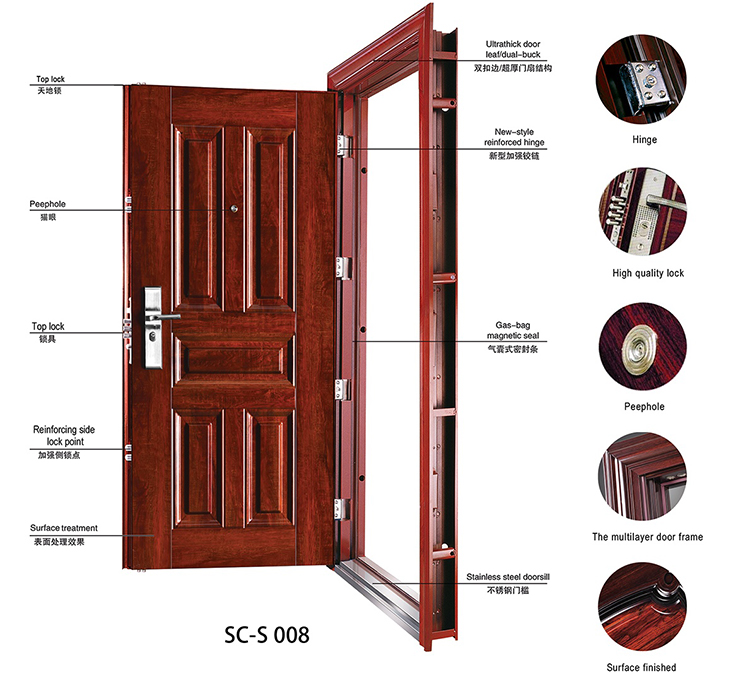7 Critical Facts About Bulletproof Doors: UL 752 vs EN Standards Exposed (+Shocking Ballistic Test Footage!)
When lives are at stake, understanding ballistic protection standards isn’t just a technical detail—it’s a critical necessity. So-called “bulletproof” doors are governed by radically different testing protocols in the United States (UL 752) versus Europe (EN 1522/1063). As global manufacturers who have supplied armored doors to banks, embassies, and high-security residences worldwide, we will decode what these ratings truly mean for your safety.
Here, we’ll share insights from our manufacturing process, including footage of our steel lamination and actual ballistic test results that will surprise you.
1. UL 752: The American Ballistic Standard
The primary standard in the United States is UL 752, managed by UL Solutions (Example External Link). It rates materials based on their ability to stop specific ammunition types.
-
✔ Protection Levels 1-10: The scale ranges from stopping common handguns (Level 1: 9mm) all the way up to high-powered military rifles (Level 8: 7.62mm NATO).
-
✔ Strict Test Method:
- Three shots are fired at a specific spacing on the test panel.
- There can be absolutely no penetration or spalling (the ejection of fragments from the back face of the armor).
- The standard also measures and limits how much the “safe side” of the door can deform upon impact.
-
Shocking Fact: A UL 752 Level 3 door must withstand three shots from a .44 Magnum, with bullets traveling at a minimum velocity of 1,400 ft/s (426 m/s).
2. EN 1063/1522: Europe’s Competing Ballistic Standard
In Europe, the governing standards are EN 1522 (for the full door set) and EN 1063 (for glazing). While similar to UL, there are key differences.
-
✔ BR Classes (BR1-BR7): The ratings range from BR1 (handguns) to BR7 (armor-piercing rifles). For example, a BR4 rating ensures protection against an AK-47.
-
✔ Key Differences vs. UL:
- Testing is often conducted at a different distance (e.g., 5 meters).
- The standard explicitly defines a “vulnerability area” behind the glass.
- It includes specific criteria for bullet fragmentation after impact.
-
Quick Comparison Chart:
-
| Threat | UL Rating | EN Rating |
-
| 9mm Handgun | Level 1 | BR1 |
-
| .357 Magnum | Level 2 | BR2 |
-
| AK-47 Rifle (7.62x39mm) | Level 7 | BR4 |
3. Inside Our Factory: The Ballistic Door Construction Process
A door’s ballistic capability comes from a multi-layered core. Here is how our armored doors are constructed:
- The Ballistic Core: This is the heart of the protection. It consists of multiple 3-12mm hardened steel plates, cross-laminated to prevent cracking and delamination under fire.
- Energy-Absorbing Layers: We bond the steel core with advanced materials like Kevlar® or UHMWPE (ultra-high-molecular-weight polyethylene), which are polymer fibers known for their incredible tensile strength that helps catch and disperse projectile energy. For higher threat levels, ceramic tiles are integrated to shatter rifle rounds.
- A Disguised Exterior: True security is invisible. The entire ballistic core is concealed beneath a finish that makes it indistinguishable from a standard luxury door, from rich wood veneers to custom powder coatings. Explore options in our Door Finishes & Design Gallery (Example Internal Link).
<!– end list –>
- See Our Production Line: [Embed 30-sec clip showing the steel lamination process]
4. Unedited Results: A Real-World Ballistic Test
Theoretical ratings are one thing; real-world performance is another. Here is the actual test data from one of our UL 752 Level 8 doors:
-
✔ Ammunition: .308 Winchester (7.62x51mm NATO)
- Muzzle Velocity: 2,800 ft/s (853 m/s)
- Impact Energy: Over 2,650 Joules
- Result: 0 Penetration. The maximum dent on the safe side after the third shot was only 11mm.
-
✔ Spall Prevention: In all tests, our doors showed less than 1mm of backside deformation, meaning no dangerous fragments entered the “safe zone.”
5. Beyond Bullets: When a Single Ballistic Rating Isn’t Enough
For maximum security, true protection often requires more than just stopping bullets. High-threat environments demand multi-functional doors.
- ✔ Multi-Threat Doors: We engineer doors that offer combined ballistic and blast-resistant properties.
- ✔ EMI/RF Shielding: For sensitive facilities, we can integrate shielding to block electronic surveillance and protect equipment.
- ✔ Certified Fire Ratings: Our doors can be certified to UL10C standards for 90 or even 180 minutes of fire protection. Learn more about our Multi-Threat Security Solutions (Example Internal Link).
6. How to Choose the Right Ballistic Door Standard (UL vs. EN)
Making the right choice is crucial for compliance and safety.
- ✅ Location: Project specifications in the US will almost always require UL-rated doors. Projects in the EU and many other regions will demand EN-rated products.
- ✅ Threat Level: The choice of level (e.g., UL 3 vs. UL 8) must be based on a professional risk assessment of the likely weapons in a specific region.
- ✅ Installation: EN-rated doors can sometimes be heavier due to different material compositions, which may require specialized framing and hardware.
7. The Future of Ballistic Materials and Technology
The field of ballistic protection is constantly advancing. We are actively researching and developing:
- ✔ Smart Armor: Doors integrated with sensors that can detect weapon signatures or impacts and automatically trigger alarms or lockdowns.
- ✔ Self-Healing Coatings: Advanced polymers that can repair minor surface damage from impacts or attempted breaches.
- ✔ Lighter, Stronger Materials: We are experimenting with graphene-enhanced composites to reduce door weight without compromising ballistic integrity.
Frequently Asked Questions (FAQ)
-
Q1: What’s the difference between “bulletproof” and “bullet-resistant”?
- A: The term “bullet-resistant” is more accurate. No material is truly “bulletproof” given enough firepower. A ballistic rating (like UL 752) certifies that a product can resist a specific number of shots from a specific caliber of weapon under tested conditions.
-
Q2: Are ballistic doors also soundproof?
- A: Yes, significantly. The dense, multi-layered core required for ballistic resistance is also excellent at blocking sound, providing a high level of acoustic insulation as a secondary benefit.
-
Q3: Can a high-level ballistic door look like a normal wooden door?
- A: Absolutely. The core principle of high-security design is discretion. Our ballistic doors are finished with custom wood, metal, or composite veneers to seamlessly match a building’s architecture.
See It To Believe It: Witness a Live Fire Test
We believe in proven performance. We regularly invite clients to our state-of-the-art facility to witness live fire tests on their own products. Because when it comes to ballistic protection, theoretical ratings aren’t enough—you need undeniable proof.






